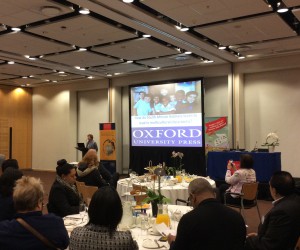The challenge of multilingualism in classrooms is an unplanned consequence of a post-1994 South Africa. With large numbers of African language learners attending schools that previously catered solely to English and Afrikaans speaking children, there remains no clear answer to the question of improving learner literacy when the language of learning and teaching (LOLT) is foreign to them.
Thankfully there is significant interest in how South African children learn to read in multi-cultural classrooms. Those who attended a recent Breakfast Indaba, hosted by Oxford University Press Southern Africa, were treated to compelling insights on the topic by Associate Professor Janet Condy of the Cape Peninsula University of Technology, and Genevieve Koopman of the Western Cape Education Department.
Multilingualism has significant implications for policymakers, learners, teachers and schools. Professor Condy observed that in many schools today, there may be as many as six languages and even more cultures represented in one classroom. However, the majority of these schools have retained the resourcing profiles of the past.
“This inevitably leads to a situation where teachers and learners speak a different language,” Genevieve Koopman explained: “learning in one’s home language offers clear linguistic, cognitive, academic and psychological benefits. Yet the future of language practice in schools has to deal with the reality of an increasingly multilingual classroom environment, the shortage of multi-lingual teachers and Foundation Phase isiXhosa teachers entering the system, a shortage of appropriate multilingual teacher training, teaching resources and learning materials,” Professor Condy noted that the legacy of our particular dynamics of race, ethnicity, culture, gender and power need to be brought to the forefront in reversing the negative impact of a prevailing dominant language culture.
Promoting African languages to equal status through the Language in Education Policy (LIEP), together with optimising the use of linguistic resources are goals that policymakers are actively pursuing. Educationalists are keenly aware that in order to bridge the gap in oral interaction, many teachers naturally code switching – alternating between two or three languages – in order to convey complex concepts; they also call upon learners to interpret for their peers, promote learner language groups and employ choral chanting, singing, rhymes and songs in an effort to accommodate different languages when teaching. In the face of a lack of multilingual learning materials, teachers create their own and translate it into isiXhosa.
“Although this is not ideal, it demonstrates a strategy to cope,” Koopman said. “Many teachers seek language support and attend workshops to familiarise themselves with curriculum content. There is good progress in the approach to teaching literacy, with a shift from teaching skills in isolation (phonics, reading, writing, communicating) to an integrated ‘whole language’ approach,” she added.
Educationalists are equally active in re-imagining a better future for all our children and are working hard on local and international pilot projects to help equip teachers to thrive, rather than survive. Professor Condy spoke of her work with the International Reading Association in implementing a diagnostic teaching model in Sri Lanka and Tanzania that combines on-going instruction, participation and assessment.
“The highly interactive and child-friendly model equips teachers to approach each lesson systematically through a process of pre-assessment, teaching (through engagement and participation) and reflection, to ascertain a learner’s ability to understand and use knowledge. This reflective pedagogy promotes questions like: how did it go, how could I have done it better and what was learned? Just as learner achievement rates have improved, so teacher satisfaction, fulfilment and joy have also increased dramatically,” Professor Condy said.
Our policymakers understand that abandoning one’s first language in favour of a more ‘esteemed’ language delays learning. Genevieve Koopman stressed that the curriculum – where it pertains to first, second and third languages – is under review and that the ideals of using home language as the primary language of education into the intermediate phase, along with a second language and the staggered introduction of a third language, is being piloted successfully in ten Western Cape schools. Furthermore, the department is working to roll out reading schemes in the next five years, to develop digital resources and to better equip teachers in training schools and with learner and teacher support materials.
The incremental introduction of African languages to our schools and training institutions remains one of many challenges that educationalists, policymakers and publishers face. In doing so, their commitment to finding solutions to multicultural, multilingual education in South Africa is as much about dealing with the ghosts of the past as it is about re-imagining the future.
This was the first in a series of Breakfast Indabas hosted by Oxford University Press Southern Africa. Managing Director Steve Cilliers is confident that debate around the future of education will benefit the key players and learners alike. “By promoting dialogue and the sharing of experience and ideas, we must enable education that takes lives from good to great, fully supported by excellent educational materials and resources,” he said.
Lundi Kompela






